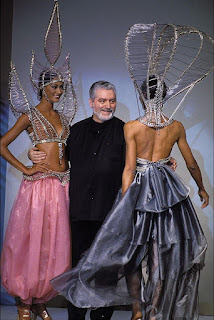by Adria Mirabelli
In the wake of Paco Rabanne’s passing we reflect on important events in the conceptual designer’s career.
On February 3, 2023 iconic designer Paco Rabanne passed away in Portsall, France at 88 years old. The eccentric designer, traditionally named Francisco Rabaneda y Cuervo, was well known for his exploratory futurist fashion design where he utilized unconventional materials such as metals, acrylic and even paper in his work.
His pieces were sculptural couture, - often made by connecting delicate pieces of metal and acrylic together with metal hoops to form garments and accessories. These innovative material explorations utilized processes that could be compared to that of creating historical chainmail. Rabanne was able to transform seemingly ordinary post-war materials into covetable pieces of high couture. His material choices were extremely modern for the time and paired with 60’s silhouettes created a striking visual code that has become synonymous with the brand to this day.
Within the realm of space-age fashion in the 1960s, Rabanne’s peers included Pierre Cardin and Andre Courrèges. Space exploration during the 60’s inspired designers to imagine what future garments might look like, and how modern fashion-people might dress in space. The movement hit a peak of popularity in the mid-60’s which faded after the 1969 moon landing. Rabanne would continue to work until his retirement in 1999.
Born in 1934 in the town of Pasajes, Spain, the Spanish Civil War was a large part of Rabanne’s childhood, - his father was a solider and was executed by the regime in power. He and his mother fled Spain and started a new life in France. Rabanne’s mother actually worked as the head seamstress for Cristóbal Balenciaga at his atelier in Spain prior to their relocation.
Enrolling in the École des Beaux Arts in Paris, Rabanne focused on architecture and industrial design. It has been said that he paid for school in part by creating fashion sketches for large fashion houses. Other historians have recorded that he did so by designing jewelry and notions for the likes of Balenciaga, Schiaparelli, and Givenchy.
Salvador Dali is quoted in saying that there were only two geniuses in Spain at the time, - him and Rabanne. We can imagine that Rabanne was a part of some exclusive creative circles during his career. Peggy Guggenheim and Diana Vreeland were early supporters of his work in the United States. This would have been a huge deal at the time, as both women were incredibly influential in their respective realms of art and fashion. What might have made Rabanne’s work so interesting is that he straddled both of these worlds.
Establishing his eponymous brand in 1966 at the age of 32, the Paco Rabanne house continues today, despite shuttering its doors briefly from 2006 – 2011.
Below we explore five important moments in the creative and eccentric designer’s career.
1. Manifesto: 12 Unwearable Dresses in Contemporary Materials (1966)
Paco Rabanne’s debut couture collection called “Manifesto: 12 Unwearable Dresses in Contemporary Materials” was presented in Paris in 1966. Most notably, the collection featured micro-mini dresses in metal, acrylic and paper using his signature chainmail technique. The collection sent waves through the fashion world and was considered highly avant-garde upon its release.
2. Françoise Hardy and the gold mini-dress (1968)
French musician Françoise Hardy would be dressed beautifully by Paco Rabanne many times during the 60s. In 1968, Rabanne created a gold minidress for Hardy utilizing 1000 gold plates which were also inlaid with three carats of diamonds along the neck-line. The three carat mini dress featured long sleeves with metal cuffs. There is even an iconic photograph of Hardy wearing the dress while speaking to Salvador Dali at a party.
3. Barbarella (1968)
Rabanne’s designs can be seen as costume inspiration in the 1968 science-fiction film “Barbarella” starring Jane Fonda and directed by her husband Roger Vadim. In the film, Fonda is a sexualized space-traveler who is costumed predominantly in short jumpsuits accessorized with Rabanne’s signature metalwork. At moments wearing ripped and torn garments, Fonda’s character was meant to be perceived as a warrior in armour. These metalwork pieces were styled alongside space-age era garments in acrylic metallics and go-go style boots.
4. The 1969 Bag
The most well-known handbag from Paco Rabanne was and continues to be the 1969 bag. Over 50 years since its design, the brand describes this bag as a “seamless surface of metal pastilles”. Featuring Rabanne’s classic chainmail technique, the 1969 bag was worn by fashion icons Françoise Hardy and Brigitte Bardot at the time of its release. In 2019 Rei Kawakubo released a reinterpretation of the 1969 bag in acrylic and metal for Comme des Garçons which further proves it’s contemporary cult-like status.
5. “Calandre” Perfume (1969)
Paco Rabanne perfumes have been very successful over the years. This began with the designer’s first perfume called “Calandre” which was released in 1969 through a collaboration with Spanish company Puig Group. Perfume remains a large part of the brand’s business and “Calandre“ is still sold today. In 1979 the perfume “Metal” was released, which Rabanne said was made for “young women who love metal accessories”. Presently, the brand has countless perfumes on the market. One of the newest perfumes, titled “Fame” features the signature metal palettes on the bottle in reference to the brands history.







